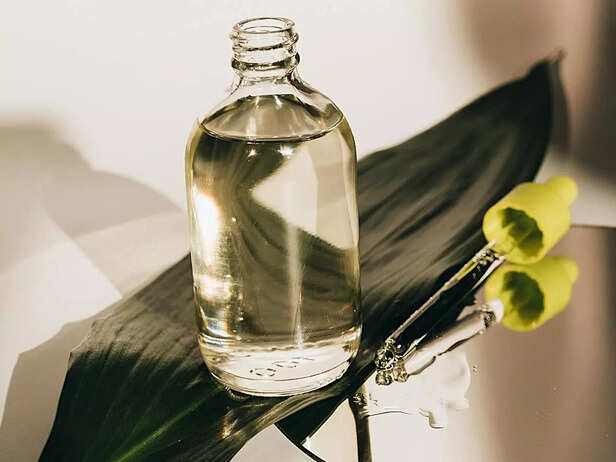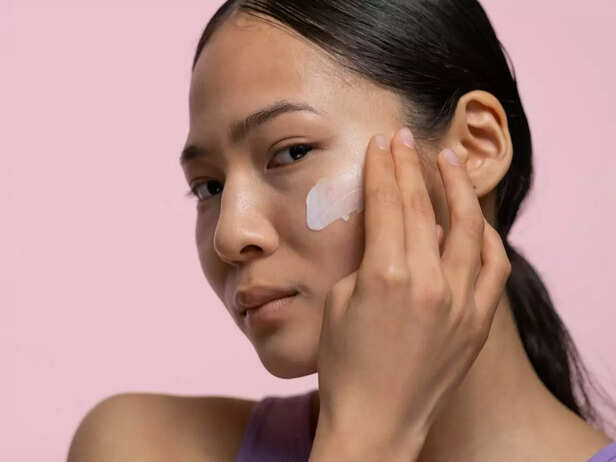Is Snail Mucin the Miracle Ingredient Your Skincare Routine is Missing?
Ritika | Sep 12, 2025, 07:11 IST
Snail Mucin
( Image credit : Freepik )
Snail mucin, or snail secretion filtrate, might sound like "ew" to those who are new, but it actually has reached the global stage in the beauty world. It is filled with hyaluronic acid, peptides, and antioxidants, which account for the rave reviews regarding hydration, healing, and smoothing wrinkles. But most studies are small, side effects are a possibility, and how the brands harvest it raises ethical issues.
The first time I saw “snail mucin” on a serum bottle, my reaction was instant: snail slime? You’ve got to be kidding. Who would willingly smear that across their face? But curiosity is a powerful thing. I caved, tried a sample, and a week later, my dry cheeks felt less like parchment. That single experience opened the door to a much bigger conversation, one that’s been gathering momentum in beauty circles for years.
What used to sound like folklore, slathering snail trails on skin, has been pulled into the glossy, modern world of skincare. Thanks to the global boom in Korean beauty and TikTok’s obsession with “miracle ingredients,” snail mucin has gone from a curiosity to a phenomenon. You’ll now find it stacked at Sephora, hyped by influencers, and even referenced in dermatology articles.

Let’s strip away the mystery. Snail mucin, more technically “snail secretion filtrate” (SSF), is the filtered goo snails naturally release. Before you wrinkle your nose, here’s why cosmetic chemists love it: it’s a cocktail of hyaluronic acid, glycolic acid, peptides, antioxidants, and allantoin. That mix ticks a lot of skincare boxes: hydration, gentle exfoliation, soothing, and repair.
According to the Journal of Integrative Dermatology (2022), mucin doesn’t just sit on top of skin; it helps lock in water, supports the barrier, calms inflammation, and even slows down enzymes that break apart collagen. That last bit is key; collagen breakdown is one of the big drivers of visible aging. So yes, it’s more than just marketing spin; the science at least partially holds up.

1. Hydration that feels real: Ask anyone who’s stuck with snail mucin for a few weeks, and they’ll tell you: the skin just feels less thirsty. A WebMD piece (2023) pointed to a small trial where hydration and texture improved. It’s not a dramatic overnight change, more like your skin quietly sighing in relief and holding onto water better than before.
2. A gentle nudge against aging: A PubMed review (2024) noted that snail extract in creams showed measurable improvements in fine lines and elasticity. No, it won’t erase wrinkles like injectables, but it seems to give the skin a push toward firmer, springier days. Think of it as support, not surgery.
3. Helping skin heal itself: Researchers looking at wound repair have found mucin speeds up regeneration in cells and animal models (Journal of Integrative Dermatology, 2022). That lines up with stories of people using it on post-acne marks or after mild cosmetic treatments, where skin needs a boost to recover calmly instead of angrily.
4. Soothing cranky skin: Redness, irritation, the kind of flare-ups that make you reach for a calming cream, snail mucin has compounds that ease that. The same journal reported anti-inflammatory and mild antimicrobial effects. That makes it a handy ally for acne-prone or eczema-sensitive users who need something gentle but not boring.
5. A maybe for skin tone: Hyperpigmentation and dark spots are trickier. There’s some evidence it helps even tone, probably by speeding cell turnover. But the research here is thinner compared to hydration or healing. It’s one of those “worth trying, but don’t bet your whole routine on it” claims.

Here’s the tricky part: it’s not just “buy, slather, glow.” Mucin works best when integrated thoughtfully.


Snail mucin tends to suit:
Key Takeaway
Snail mucin isn’t just hype; it’s one of those ingredients that actually backs up part of its reputation. Hydration? Yes. Soothing? Yes. Some collagen and scar support? Promising. But miracle worker? Not actually.
The clever approach? Patch test, begin gradually, and set reasonable expectations. Some see the difference in a week, some take a month. Some adore it for life; others drop it after a bottle.
And that’s okay. Because skincare isn’t about miracle fixes. It’s about consistency, care, and paying attention to what your skin is actually telling you, even if that lesson comes from the trail of a snail.
Explore the latest trends and tips in Health & Fitness, Spiritual, Travel, Life Hacks, Trending, Fashion & Beauty, and Relationships at Times Life!
Frequently Asked Questions (FAQs)
What used to sound like folklore, slathering snail trails on skin, has been pulled into the glossy, modern world of skincare. Thanks to the global boom in Korean beauty and TikTok’s obsession with “miracle ingredients,” snail mucin has gone from a curiosity to a phenomenon. You’ll now find it stacked at Sephora, hyped by influencers, and even referenced in dermatology articles.
What Is Snail Mucin?

Snail Mucin
( Image credit : Pexels )
Let’s strip away the mystery. Snail mucin, more technically “snail secretion filtrate” (SSF), is the filtered goo snails naturally release. Before you wrinkle your nose, here’s why cosmetic chemists love it: it’s a cocktail of hyaluronic acid, glycolic acid, peptides, antioxidants, and allantoin. That mix ticks a lot of skincare boxes: hydration, gentle exfoliation, soothing, and repair.
According to the Journal of Integrative Dermatology (2022), mucin doesn’t just sit on top of skin; it helps lock in water, supports the barrier, calms inflammation, and even slows down enzymes that break apart collagen. That last bit is key; collagen breakdown is one of the big drivers of visible aging. So yes, it’s more than just marketing spin; the science at least partially holds up.
Benefits: What It Actually Seems to Do

Snail mucin face mask sheet
( Image credit : Unsplash )
1. Hydration that feels real: Ask anyone who’s stuck with snail mucin for a few weeks, and they’ll tell you: the skin just feels less thirsty. A WebMD piece (2023) pointed to a small trial where hydration and texture improved. It’s not a dramatic overnight change, more like your skin quietly sighing in relief and holding onto water better than before.
2. A gentle nudge against aging: A PubMed review (2024) noted that snail extract in creams showed measurable improvements in fine lines and elasticity. No, it won’t erase wrinkles like injectables, but it seems to give the skin a push toward firmer, springier days. Think of it as support, not surgery.
3. Helping skin heal itself: Researchers looking at wound repair have found mucin speeds up regeneration in cells and animal models (Journal of Integrative Dermatology, 2022). That lines up with stories of people using it on post-acne marks or after mild cosmetic treatments, where skin needs a boost to recover calmly instead of angrily.
4. Soothing cranky skin: Redness, irritation, the kind of flare-ups that make you reach for a calming cream, snail mucin has compounds that ease that. The same journal reported anti-inflammatory and mild antimicrobial effects. That makes it a handy ally for acne-prone or eczema-sensitive users who need something gentle but not boring.
5. A maybe for skin tone: Hyperpigmentation and dark spots are trickier. There’s some evidence it helps even tone, probably by speeding cell turnover. But the research here is thinner compared to hydration or healing. It’s one of those “worth trying, but don’t bet your whole routine on it” claims.
How to Use It Without Regret

Girl applying cream on her face
( Image credit : Pexels )
Here’s the tricky part: it’s not just “buy, slather, glow.” Mucin works best when integrated thoughtfully.
- Patch test first: Apply a dab behind your ear or on your inner arm, then wait 24–48 hours. Rare, but allergic reactions do happen.
- Start slow: Once daily or even every other day is safer than piling it on.
- Check the label: Higher percentages of filtrate are better, and the fewer unnecessary extras, like heavy fragrance or strong alcohols, the kinder it’ll be to sensitive skin.
- Layer smartly: Pair with ceramide moisturizers to reinforce the barrier. Don’t overload with other strong actives.
- Always, always sunscreen: UV rays undo collagen faster than snail mucin can save it.
The Side Effects Nobody Talks Enough About

Woman looking in the mirror
( Image credit : Pexels )
- Allergic Reactions: If you’re allergic to snails or shellfish, tread carefully. Reactions like redness or swelling have been reported (Health.com, 2023).
- Formulation Traps: Sometimes it’s not the mucin but the added fragrance or preservatives that cause irritation.
- Research Gaps: Many studies are either lab-based or small human trials. Promising, yes, but far from definitive (PubMed, 2024).
- Ethical Questions: How is mucin collected? Are snails harmed? The answer depends on the brand. Some use stress-free collection methods, others aren’t transparent. Sustainability and cruelty-free practices remain murky.
Who Might Benefit, and Who Should Skip It

Woman doing skincare
( Image credit : Pexels )
Snail mucin tends to suit:
- Dry or sensitive skin types in need of hydration.
- People easing into anti-aging but are wary of harsher ingredients.
- Anyone healing from non-invasive cosmetic procedures.
- You have mollusk or shellfish allergies.
- You’re highly acne-prone, and heavy serums clog your pores.
- You already layer strong actives, retinoids, AHAs, BHAs, since piling mucin on top could push your skin into irritation territory.
Key Takeaway
The clever approach? Patch test, begin gradually, and set reasonable expectations. Some see the difference in a week, some take a month. Some adore it for life; others drop it after a bottle.
And that’s okay. Because skincare isn’t about miracle fixes. It’s about consistency, care, and paying attention to what your skin is actually telling you, even if that lesson comes from the trail of a snail.
Explore the latest trends and tips in Health & Fitness, Spiritual, Travel, Life Hacks, Trending, Fashion & Beauty, and Relationships at Times Life!
Frequently Asked Questions (FAQs)
- Do different snail species affect mucin quality?
Yes. The species and extraction method can drastically impact the mucin’s composition, texture, and efficacy. - Are snails killed for mucin?
No, the known and reputable manufacturers do not kill the snails rather collect it live from the snails that are farmed which are treated with comfort during the process. - When to use snail mucin in routine?
After cleansing your face and before applying any other product like moisturizer or other serums.
